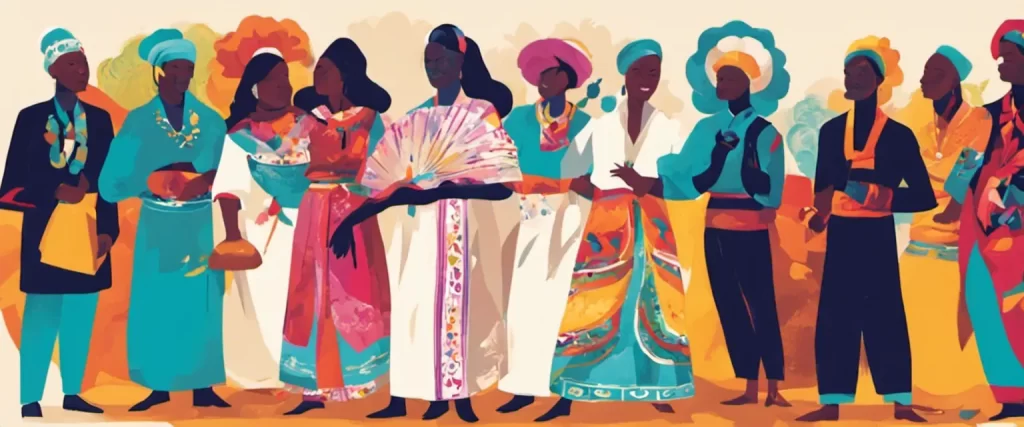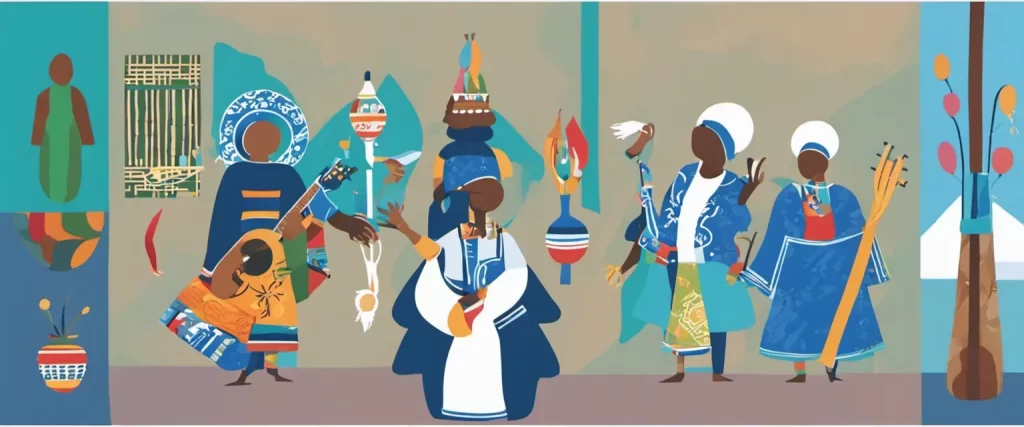
What is Local Culture
Local culture refers to the beliefs, customs, practices, traditional arts, values, and social norms that exist within a particular geographic area or community. It includes the unique behaviors, traditions, and ways of life that are passed down from generation to generation. Local culture is influenced by various factors such as history, geography, religion, language, ethnicity, and socio-economic conditions. It may include aspects such as language, cuisine, music, dance, clothing, festivals, rituals, and social interactions. Local culture plays a significant role in shaping the identity and sense of belonging of individuals within a community, as well as preserving and promoting cultural heritage.
What Can We Get From Local Culture
Local culture can provide numerous benefits, including:
1. Historical insights: Local culture can preserve and pass down knowledge about the history of a region, providing valuable insights into the roots and development of a community.
2. Unique traditions and customs: Local culture often showcases distinctive traditions, customs, and rituals that have been practiced for generations. These can provide a deeper understanding of a community’s values, beliefs, and way of life.
3. Authentic experiences: Engaging with local culture allows visitors and residents to experience the true essence of a place. This can include enjoying local cuisine, participating in traditional festivals, or visiting historical landmarks that are integral to the local culture.
4. Cultural diversity and tolerance: Exploring local culture promotes cultural diversity and fosters empathy and understanding towards different traditions, beliefs, and lifestyles. This can enhance tolerance and appreciation for diverse cultures within a society.
5. Art and creativity: Local culture often nurtures artistic expression in various forms, such as music, dance, literature, and crafts. Exposure to local art can inspire creativity, foster appreciation for different art forms, and encourage the preservation of traditional craftsmanship.
6. Connection to the natural environment: Many local cultures have strong connections to the natural environment, emphasizing sustainability, ecological knowledge, and harmonious coexistence with nature. Learning from these cultures can foster a deeper appreciation for the environment and encourage sustainable practices.
7. Sense of identity and belonging: Understanding and embracing local culture can contribute to a sense of identity and belonging for both locals and visitors. It provides a sense of rootedness, pride, and connection to a specific community or region.
8. Economic benefits: Local culture often boosts tourism and generates economic opportunities for communities. By preserving and promoting their unique cultural heritage, communities can attract visitors, create jobs, and support local businesses.
Overall, local culture enriches our lives by offering insights, experiences, and connections to the history, traditions, and people of a specific community or region.
Strategies in Learning Local Culture
1. Immerse yourself in the local community: Engage with local people and participate in their traditions, events, and activities. This could include attending festivals, visiting local markets, joining community clubs or organizations, or volunteering for local causes. By actively participating, you’ll develop a better understanding of the local culture.
2. Learn the language: Language is an essential part of any culture. Take language classes or use language-learning apps to become proficient in the local language. This will not only help you communicate effectively but also gain deeper insights into the local customs, idioms, and expressions.
3. Read books and watch movies: Explore literature or films that showcase the local culture. This will provide you with a narrative perspective and allow you to gain a better understanding of the values, beliefs, and traditions of the community.
4. Try local cuisine: Food plays a significant role in cultural identity. Experiment with local dishes, visit local restaurants, or take cooking classes to learn how to prepare traditional meals. This will give you a taste of the local customs and traditional ingredients.
5. Visit historical and cultural landmarks: Explore museums, historical sites, temples, or any other significant landmarks in the local area. These places often provide historical, artistic, or cultural context that can deepen your understanding of the local culture.
6. Engage with locals on social media or online communities: Join online forums, social media groups, or discussion boards where locals share information about their culture. Ask questions, participate in discussions, and learn from their experiences.
7. Respect local customs and traditions: It is crucial to be mindful and respectful of local customs, traditions, and social norms. Observe how locals behave, dress, and interact in different situations and adapt your behavior accordingly. This shows your respect and willingness to learn and engage with the local culture.
8. Build relationships with locals: Establishing genuine connections with locals can provide you with firsthand insights into their culture. Make an effort to forge friendships or find a mentor who can guide you and share their experiences and knowledge about the local culture.
9. Keep an open mind: Embrace the differences between your own culture and the local culture. Avoid making judgments and be open to new perspectives, practices, and beliefs. Stay curious, adaptable, and willing to learn throughout your cultural immersion journey.
10. Reflect and write about your experiences: Keep a journal or blog where you can reflect on your experiences, observations, and learnings. Writing can help solidify your understanding and make connections between different aspects of the local culture. It also serves as a resource to look back on and share with others interested in learning about the culture.

Jerusalem: The Biography by Simon Montefiore
Summary
Jerusalem: The Biography” by Simon Montefiore is a comprehensive account that explores the 3,000-year history of the holy city. The book takes readers on an epic journey from the earliest archaeological findings to modern times, giving an intricate and engaging portrait of Jerusalem’s evolving political, religious, and cultural significance.
Montefiore delves into the numerous conquerors and empires that shaped the city, from the ancient Egyptians, Israelites, and Babylonians, to the Romans, Crusaders, and Ottomans. He highlights the city’s role as a spiritual center for Judaism, Christianity, and Islam, chronicling the building and destruction of temples, churches, and mosques that have defined the city’s sacred landscape.
Throughout the book, Montefiore weaves together personal anecdotes, diaries, and memoirs from those who lived in Jerusalem, providing a human element to its complex history. He explores the lives of kings, conquerors, religious leaders, and ordinary citizens, showcasing the city’s triumphs and tragedies through their experiences.
The book also investigates the ongoing conflicts and power struggles that have plagued Jerusalem, from the struggles between the Islamic and Christian world during the Crusades, to the modern-day Israeli-Palestinian conflict. Montefiore offers a balanced perspective on the various political, cultural, and religious forces that have shaped Jerusalem’s destiny and continue to impact its present and future.
Overall, “Jerusalem: The Biography” is a compelling, well-researched book that presents an in-depth and vivid account of one of the world’s most significant cities. Montefiore skillfully combines historical analysis, personal narratives, and cultural insights to create a captivating narrative that offers readers a deep understanding of Jerusalem’s rich and complex past.
Reasons for Recommendation
1. Rich Historical Context: “Jerusalem: The Biography” offers readers an incredibly detailed and comprehensive account of the city’s rich historical background. The book delves into the various political, religious, and cultural influences that have shaped Jerusalem over thousands of years. By reading this book, one gains a deep understanding of the city’s local culture and how it has evolved over time.
2. Authentic Narratives: Montefiore’s writing style brings Jerusalem’s local culture to life. He weaves together the stories of the city’s diverse inhabitants – from the ancient Israelites and Romans to Muslims, Christians, and Jews – offering readers an intimate look into their daily lives, traditions, and beliefs. This allows readers to truly connect with the local culture of the city throughout its history.
3. Multidimensional Perspectives: The book provides a balanced perspective by incorporating the viewpoints and experiences of Jerusalem’s different communities. Montefiore delves into the complexities of interfaith relations in the city, shedding light on various tensions, collaborations, and shared cultural practices. By understanding the multiple perspectives of the locals, readers gain a nuanced understanding of the city’s cultural fabric.
4. Beautiful Descriptions: Montefiore’s vivid descriptions of the city’s landmarks, architecture, and landscapes help readers visualize and experience Jerusalem’s local culture. From the stunning Dome of the Rock to the bustling markets of the Old City, the book paints a fascinating picture of the city’s physical and cultural landscapes, enabling readers to immerse themselves in its local culture through imagery.
5. Unraveling Myths and Stereotypes: By exploring the rich tapestry of Jerusalem’s local culture, the book challenges many myths and stereotypes associated with the city. It offers a more nuanced and accurate understanding of Jerusalem’s complexities, debunking simplistic assumptions and presenting a more comprehensive view of its multi-layered and diverse local culture.
6. Inspiring Further Exploration: “Jerusalem: The Biography” acts as a gateway to deeper exploration of Jerusalem’s local culture. Montefiore provides the reader with a vast array of primary and secondary sources, allowing interested readers to delve further into specific events, people, and periods covered in the book. This encourages readers to continue their journey of understanding and appreciation for Jerusalem’s local culture beyond the pages of this biography.

Natasha’s Dance by Orlando Figes
Summary
Natasha’s Dance: A Cultural History of Russia” by Orlando Figes is a comprehensive exploration of the rich cultural history of Russia. The book takes a thematic approach, covering various aspects of Russian culture and society from the 18th century to the present day.
Figes delves into the country’s literature, visual arts, music, and architecture, as well as religious and political ideologies. He also explores cultural tensions that have shaped Russian identity, such as the divide between the Westernizers and Slavophiles, and the tensions between different regions within Russia itself.
The book begins with an exploration of St. Petersburg, the city founded by Peter the Great, and how it became a symbol of the country’s aspirations to be a modern European power. Figes then delves into the literary world, discussing figures such as Pushkin, Tolstoy, and Dostoevsky, and examining how their works reflected and shaped Russian society.
Figes also provides insights into the economic and social changes that occurred throughout Russian history, including the tensions between the rural peasantry and the urban elite. He describes the impact of the Bolshevik Revolution and the subsequent Soviet era on culture and the arts, including the censorship and control imposed by the state.
Throughout the book, Figes weaves a narrative of Russia’s search for its own cultural identity and its complex relationship with the West. He highlights significant events and individuals, showcasing their influence on Russian culture, and provides a nuanced understanding of Russia’s artistic and intellectual endeavors.
Overall, “Natasha’s Dance” is a sweeping narrative that explores the multifaceted and ever-evolving cultural history of Russia, offering readers a deep and comprehensive understanding of this rich and complex society.
Reasons for Recommendation
1. Deep exploration of Russian cultural history: “Natasha’s Dance” delves into the rich tapestry of Russian culture, tracing its origins and tracing its development over the centuries. From literature to music, art to architecture, the book uncovers the unique qualities that shape Russian identity.
2. In-depth analysis of Russian art and literature: The book explores the works of renowned Russian artists, writers, and composers, such as Pushkin, Tolstoy, Tchaikovsky, and Repin. By understanding the cultural context and influence on these artists, readers gain a more profound appreciation for the beauty and depth of Russian art and literature.
3. Examination of folk traditions and customs: “Natasha’s Dance” goes beyond the works of famous figures and also dives into the multifaceted world of folk traditions and customs. By exploring festivals, rituals, and everyday practices, readers gain insight into the lesser-known aspects of Russian culture, deepening their understanding of local traditions.
4. Exploration of the diverse regions of Russia: The book takes readers on a journey across different regions of Russia, highlighting the uniqueness and regional cultural variations. By showcasing the diversity within the country, readers gain a broader perspective on the complexity of Russian culture.
5. Insight into the impacts of historical events on culture: Orlando Figes weaves together historical events and cultural developments to show how they shape and influence each other. By understanding the cultural repercussions of significant historical events, readers gain a more comprehensive understanding of Russia and its people.
6. Illustration of the resilience of Russian culture: Despite the challenges and upheavals faced throughout history, “Natasha’s Dance” highlights the resilience of Russian culture. By exploring how various cultural elements adapt and survive amidst changing societal landscapes, readers gain an appreciation for the enduring spirit of Russian culture.
7. Thought-provoking analysis and storytelling: Orlando Figes presents complex concepts and historical narratives in a captivating and accessible manner. Through engaging storytelling and insightful analysis, readers are encouraged to reflect on the connections between culture, history, and identity.
Overall, “Natasha’s Dance” offers a comprehensive, insightful, and engaging exploration of Russian culture from a local perspective, making it a highly recommended book for those interested in deepening their understanding of this rich and diverse culture.
The Rape of Nanking by Iris Shun-Ru Chang
Summary
The Rape of Nanking: The Forgotten Holocaust of World War II” by Iris Chang is a non-fiction book that sheds light on the tragic events that took place in Nanking, China, during the Japanese occupation in 1937. Chang’s book details the atrocities committed by Japanese soldiers which resulted in the massacre, rape, and brutalization of thousands of Chinese civilians and prisoners of war.
The book begins by providing historical context, discussing the lead-up to the Japanese invasion of China and the subsequent capture of Nanking. Chang then delves into the horrifying details of what unfolded after the city’s fall. Japanese soldiers engaged in widespread looting, arson, and murder, indiscriminately targeting men, women, children, and the elderly.
Chang presents first-hand accounts from survivors and uses testimonies from both Chinese and Japanese sources to illustrate the extent of the atrocities. The author emphasizes the systematic rape of thousands of women and girls, often followed by their brutal murder or suicide. Many civilians were subjected to prolonged torture and sexual slavery. Chang also highlights the use of mass executions, bayonet practice on live captives, and the desecration of corpses as symbols of the extreme cruelty exhibited by the Japanese soldiers.
In addition to documenting the events themselves, Chang explores the aftermath of the Nanking Massacre. She examines the lack of recognition and justice for the victims, as well as the attempts made by the Japanese government to downplay or deny the severity of the atrocities. Chang also acknowledges the role of individuals such as John Rabe, a German businessman, and the surviving Nanking residents who risked their lives to protect and shelter others during the occupation.
Overall, “The Rape of Nanking” by Iris Chang serves as a harrowing reminder of the brutality of war and the devastating consequences it can have on innocent civilians. By bringing attention to this often-forgotten chapter of World War II, Chang exposes the deeply disturbing actions committed by the invading Japanese soldiers, seeking to ensure that history accurately remembers the victims and the horrors they endured.
Reasons for Recommendation
1. Preservation of local history: The book provides a detailed and comprehensive account of the atrocities committed during the Nanking Massacre, ensuring that the experiences and voices of the local Chinese population are not forgotten or overlooked.
2. Promoting cultural empathy: By exploring the local culture and its impact on the people of Nanking, the book promotes understanding and empathy towards the survivors’ experiences and their longstanding cultural legacy.
3. Understanding the local perspective: The author, Iris Chang, extensively investigates and incorporates the perspectives of local people who witnessed and endured the Nanking Massacre. This allows readers to gain insights into the specific cultural, social, and psychological ramifications suffered by the local community during this dark time.
4. Promoting healing and reconciliation: The book delves into the efforts made by the local community to heal and rebuild their lives after the massacre. It highlights the resilience, determination, and cultural values that helped in reconstructing their identity and fostering reconciliation.
5. Raising awareness and addressing historical revisionism: The Rape of Nanking sheds light on the often neglected or downplayed historical events. By examining local cultural aspects in the context of the massacre, the book provides a counter-narrative against any attempts to deny or revise the historical reality of the events.
6. Encouraging dialogue and respect: By using the perspective of local culture, the book invites readers to engage in discourse and discussion about the importance of respecting diverse cultural heritage and recognizing the impacts of violence on communities.
7. Highlighting the connection between historical events and current cultural identity: The book explores the lasting impact of the Nanking Massacre on the local culture, emphasizing its role in shaping the identity, memory, and resilience of the Nanking community even today.
8. Celebrating cultural resilience: Despite the unimaginable horrors faced, the book showcases the perseverance and resilience of the local population in preserving their cultural traditions, values, and identity during and after the Nanking Massacre.
9. Promoting cultural preservation and education: By recommending The Rape of Nanking, readers can contribute to the wider dissemination of knowledge and awareness about the Nanking Massacre, helping to ensure that future generations are educated about the importance of preserving and respecting local culture.
10. Empowering marginalized voices: By championing the local perspective, the book amplifies the voices of those affected by the Nanking Massacre, empowering them in their struggle for recognition, understanding, and justice.